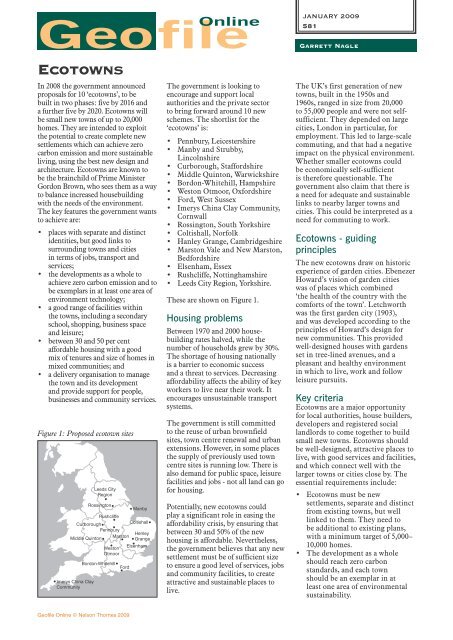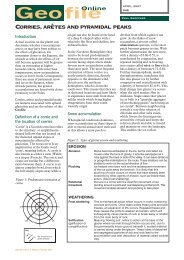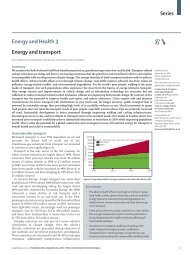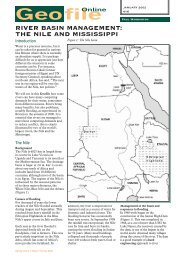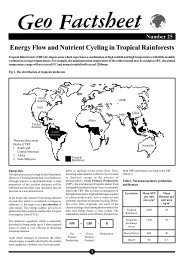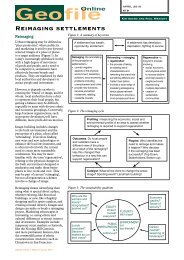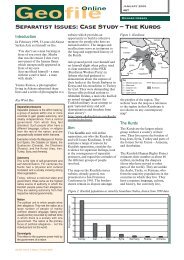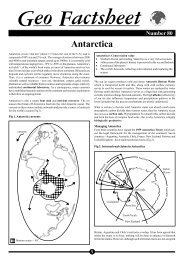Geofile Online - Richmond School District No. 38
Geofile Online - Richmond School District No. 38
Geofile Online - Richmond School District No. 38
You also want an ePaper? Increase the reach of your titles
YUMPU automatically turns print PDFs into web optimized ePapers that Google loves.
<strong>Geofile</strong><br />
<strong>Online</strong><br />
Ecotowns<br />
In 2008 the government announced<br />
proposals for 10 ‘ecotowns’, to be<br />
built in two phases: five by 2016 and<br />
a further five by 2020. Ecotowns will<br />
be small new towns of up to 20,000<br />
homes. They are intended to exploit<br />
the potential to create complete new<br />
settlements which can achieve zero<br />
carbon emission and more sustainable<br />
living, using the best new design and<br />
architecture. Ecotowns are known to<br />
be the brainchild of Prime Minister<br />
Gordon Brown, who sees them as a way<br />
to balance increased housebuilding<br />
with the needs of the environment.<br />
The key features the government wants<br />
to achieve are:<br />
• places with separate and distinct<br />
identities, but good links to<br />
surrounding towns and cities<br />
in terms of jobs, transport and<br />
services;<br />
• the developments as a whole to<br />
achieve zero carbon emission and to<br />
be exemplars in at least one area of<br />
environment technology;<br />
• a good range of facilities within<br />
the towns, including a secondary<br />
school, shopping, business space<br />
and leisure;<br />
• between 30 and 50 per cent<br />
affordable housing with a good<br />
mix of tenures and size of homes in<br />
mixed communities; and<br />
• a delivery organisation to manage<br />
the town and its development<br />
and provide support for people,<br />
businesses and community services.<br />
Figure 1: Proposed ecotown sites<br />
Leeds City<br />
Region<br />
Rossington<br />
Manby<br />
Rushcliffe<br />
Curborough<br />
Coltishall<br />
Pennbury<br />
Henley<br />
Middle Quinton<br />
Marston<br />
Grange<br />
Weston<br />
Elsenham<br />
Otmoor<br />
Imerys China Clay<br />
Community<br />
Bordon-Whitehill<br />
Ford<br />
The government is looking to<br />
encourage and support local<br />
authorities and the private sector<br />
to bring forward around 10 new<br />
schemes. The shortlist for the<br />
‘ecotowns’ is:<br />
• Pennbury, Leicestershire<br />
• Manby and Strubby,<br />
Lincolnshire<br />
• Curborough, Staffordshire<br />
• Middle Quinton, Warwickshire<br />
• Bordon-Whitehill, Hampshire<br />
• Weston Otmoor, Oxfordshire<br />
• Ford, West Sussex<br />
• Imerys China Clay Community,<br />
Cornwall<br />
• Rossington, South Yorkshire<br />
• Coltishall, <strong>No</strong>rfolk<br />
• Hanley Grange, Cambridgeshire<br />
• Marston Vale and New Marston,<br />
Bedfordshire<br />
• Elsenham, Essex<br />
• Rushcliffe, <strong>No</strong>ttinghamshire<br />
• Leeds City Region, Yorkshire.<br />
These are shown on Figure 1.<br />
Housing problems<br />
Between 1970 and 2000 housebuilding<br />
rates halved, while the<br />
number of households grew by 30%.<br />
The shortage of housing nationally<br />
is a barrier to economic success<br />
and a threat to services. Decreasing<br />
affordability affects the ability of key<br />
workers to live near their work. It<br />
encourages unsustainable transport<br />
systems.<br />
The government is still committed<br />
to the reuse of urban brownfield<br />
sites, town centre renewal and urban<br />
extensions. However, in some places<br />
the supply of previously used town<br />
centre sites is running low. There is<br />
also demand for public space, leisure<br />
facilities and jobs - not all land can go<br />
for housing.<br />
Potentially, new ecotowns could<br />
play a significant role in easing the<br />
affordability crisis, by ensuring that<br />
between 30 and 50% of the new<br />
housing is affordable. Nevertheless,<br />
the government believes that any new<br />
settlement must be of sufficient size<br />
to ensure a good level of services, jobs<br />
and community facilities, to create<br />
attractive and sustainable places to<br />
live.<br />
January 2009<br />
581<br />
Garrett Nagle<br />
The UK’s first generation of new<br />
towns, built in the 1950s and<br />
1960s, ranged in size from 20,000<br />
to 55,000 people and were not selfsufficient.<br />
They depended on large<br />
cities, London in particular, for<br />
employment. This led to large-scale<br />
commuting, and that had a negative<br />
impact on the physical environment.<br />
Whether smaller ecotowns could<br />
be economically self-sufficient<br />
is therefore questionable. The<br />
government also claim that there is<br />
a need for adequate and sustainable<br />
links to nearby larger towns and<br />
cities. This could be interpreted as a<br />
need for commuting to work.<br />
Ecotowns - guiding<br />
principles<br />
The new ecotowns draw on historic<br />
experience of garden cities. Ebenezer<br />
Howard’s vision of garden cities<br />
was of places which combined<br />
‘the health of the country with the<br />
comforts of the town’. Letchworth<br />
was the first garden city (1903),<br />
and was developed according to the<br />
principles of Howard’s design for<br />
new communities. This provided<br />
well-designed houses with gardens<br />
set in tree-lined avenues, and a<br />
pleasant and healthy environment<br />
in which to live, work and follow<br />
leisure pursuits.<br />
Key criteria<br />
Ecotowns are a major opportunity<br />
for local authorities, house builders,<br />
developers and registered social<br />
landlords to come together to build<br />
small new towns. Ecotowns should<br />
be well-designed, attractive places to<br />
live, with good services and facilities,<br />
and which connect well with the<br />
larger towns or cities close by. The<br />
essential requirements include:<br />
• Ecotowns must be new<br />
settlements, separate and distinct<br />
from existing towns, but well<br />
linked to them. They need to<br />
be additional to existing plans,<br />
with a minimum target of 5,000–<br />
10,000 homes.<br />
• The development as a whole<br />
should reach zero carbon<br />
standards, and each town<br />
should be an exemplar in at<br />
least one area of environmental<br />
sustainability.<br />
<strong>Geofile</strong> <strong>Online</strong> © Nelson Thornes 2009<br />
GeoFile Series 27 Issue 2<br />
Fig 581_01 Mac/eps/illustrator 11 s/s
January 2009 no.581 Ecotowns<br />
Figure 2: Weston Otmoor<br />
M40<br />
Brownfield<br />
MOD land<br />
Akeman Street<br />
M40<br />
A41<br />
Bicester<br />
Weston-onthe-Green<br />
Wendlebury<br />
Junction 99<br />
Weston-onthe-Green<br />
Junction 9<br />
A34<br />
M40<br />
Outer greenbelt<br />
boundary<br />
SSSI<br />
A34<br />
Potential area<br />
of development<br />
Railway line<br />
• Ecotown proposals should<br />
provide for a good range of<br />
facilities within the town - a<br />
secondary school, a mediumscale<br />
retail centre, good quality<br />
business space and leisure<br />
facilities.<br />
• Affordable housing should make<br />
up between 30 and 50% of the<br />
total through a wide range and<br />
distribution of tenures in mixed<br />
communities, with a particular<br />
emphasis on larger family<br />
homes.<br />
• A management body will help<br />
develop the town, provide<br />
support for people moving to the<br />
new community, for businesses<br />
and to co-ordinate delivery of<br />
services and manage facilities.<br />
Key design aspects<br />
1. Environment and carbon<br />
• Incorporate renewable energy<br />
systems such that not only<br />
homes, but schools, shops, offices<br />
and community facilities can<br />
reach zero carbon standards, with<br />
innovative town-scale generation<br />
of renewable energy. Zero carbon<br />
means no net carbon emissions<br />
from all energy uses, so the<br />
amount of energy taken from the<br />
national grid is less than or equal<br />
to the amount put back through<br />
renewable technologies.<br />
• Demonstrate excellence<br />
in one particular aspect of<br />
environmental sustainability<br />
- for example technological<br />
sustainability, such as more<br />
advanced renewable and energyefficient<br />
technologies, sustainable<br />
urban drainage/wastewater<br />
GeoFile Series 27 Issue 2<br />
Fig 581_02 treatment/grey Mac/eps/illustrator water recycling 11 s/s or<br />
NELSON waste management THORNES PUBLISHING systems.<br />
• Artist: Planned David in Russell a way Illustration which supports<br />
low carbon living and minimises<br />
carbon emissions from transport.<br />
• Incorporate high standards of<br />
water efficiency.<br />
• Incorporate environmentally<br />
sustainable approaches to<br />
managing waste, wastewater,<br />
drainage and flooding.<br />
• Integrate green space and<br />
features to enhance biodiversity.<br />
• Use construction methods and<br />
materials which have a low<br />
environmental impact and generate<br />
minimum construction waste.<br />
2. Design<br />
• A commitment to high standards<br />
of architecture and urban design.<br />
3. Transport<br />
• An area-wide travel plan should<br />
be provided for each ecotown<br />
scheme.<br />
• High-quality public transport<br />
links to reduce car dependency.<br />
• Minimising the need to travel<br />
by locating key public services<br />
together.<br />
• Management of demand through<br />
traffic control measures and<br />
giving priority to public transport<br />
and high occupancy vehicles.<br />
• Consideration of the impact on<br />
roads and congestion when siting<br />
the ecotown.<br />
4. Community<br />
• Community empowerment<br />
– giving local people a part in the<br />
decision-making process.<br />
• Encourage active communities<br />
by creating the conditions for<br />
community participation and<br />
involvement in civic activity.<br />
5. Jobs as well as homes<br />
• A clear economic strategy for the<br />
town.<br />
• Encourage working from home<br />
through live/work units or in<br />
local resource centres, supported<br />
by wi-fi (wireless) and other<br />
information technology (IT)<br />
networks.<br />
6. Health<br />
• Promote healthy and sustainable<br />
environments.<br />
• Offer choices for healthy living.<br />
7. Land use<br />
• Schemes should make use of<br />
suitable surplus public sector land<br />
or brownfield land.<br />
• Appropriate use of land in terms<br />
of quality and mitigation of<br />
impacts on biodiversity.<br />
• Sustainable locations, which<br />
relate well to existing networks of<br />
surrounding towns and villages.<br />
Ecotowns in Oxfordshire<br />
Two separate schemes to build<br />
major ecotowns near Kidlington<br />
and also at Weston-on-the-Green<br />
were submitted to the government.<br />
Cherwell <strong>District</strong> Council’s<br />
executive expressed concern about<br />
the Weston-on-the-Green scheme<br />
and the other ecotown proposal<br />
to build 5,000 homes at Shipton<br />
Quarry, a former cement works<br />
between Woodstock and Bicester.<br />
<strong>Geofile</strong> <strong>Online</strong> © Nelson Thornes 2009
January 2009 no.581 Ecotowns<br />
A statement from the council said:<br />
‘The two candidate locations offer some<br />
advantages, such as the reuse of previously<br />
developed land and the potential to<br />
improve public transport.<br />
But there are significant disadvantages,<br />
including adverse effects upon the Green<br />
Belt, effects upon rural roads, the impact<br />
on nature conservation sites, the loss of<br />
agricultural land and the impact on the<br />
regeneration of existing towns.’<br />
Weston Otmoor<br />
A settlement of 15,000 new ecohomes<br />
near Weston-on-the-Green<br />
had made it on to the government<br />
shortlist of 15 proposed schemes, 10<br />
of which are expected to be built.<br />
Stretching across two sides of the<br />
A34, from Weston-on-the-Green in<br />
the west to the M40 in the east, and<br />
from RAF Weston-on-the-Green in<br />
the north to the Oxford–Bicester<br />
railway line in the south, the site<br />
totals almost 2,000 acres (Figure 2).<br />
According to the Weston Front<br />
Action Group, ‘The village [Westonon-the-Green]<br />
is resolved to defeat<br />
the proposed plans for Weston<br />
Otmoor by the developers Parkridge,<br />
and the landowners who have sold<br />
options.’ The fact that part of the<br />
site is in the Green Belt and contains<br />
a site of special scientific interest<br />
has not put off the Government, nor<br />
the fact that the massive site being<br />
put forward is bisected by the trunk<br />
road.<br />
Parkridge, the developers, is partowned<br />
by the global American<br />
property company US Reit<br />
ProLogics. What it wants to do in<br />
Oxfordshire is build a settlement<br />
bigger than Bicester that would be<br />
home to 25,000 people, growing<br />
eventually to 35,000, with 10 schools<br />
(two secondary, eight primary) and<br />
15,000 properties, offering a range of<br />
dwelling types, including affordable<br />
homes.<br />
Parkridge already controls 1,600<br />
acres of the site through options to<br />
buy farmland from a consortium<br />
of landowners. It is now in talks<br />
to acquire the remaining 325 acres<br />
from the Ministry of Defence to<br />
buy an airstrip used as a parachute<br />
training drop zone.<br />
Ironically, the Housing Minister’s<br />
statement referred to Weston<br />
Otmoor as a scheme to build<br />
between 10,000 and 15,000 homes<br />
‘on brownfield land three miles<br />
Figure 3: Shipton<br />
Wootton<br />
Woodstock<br />
Long Hanborough<br />
Key<br />
A44<br />
Bladon<br />
Church Hanborough<br />
Settlements<br />
Rivers<br />
Swinford<br />
Bunkers<br />
Hill<br />
Cassington<br />
Tackley<br />
SHIPTON<br />
Oxford<br />
Airport<br />
Begbroke<br />
Yarton<br />
A40<br />
Wytham<br />
A44<br />
south of Bicester’. According believed it made a mockery of the<br />
to the chairman of Oxfordshire GeoFile Series 27 term Issue 2‘sustainable’ development. The<br />
CPRE (Campaign to Fig Protect 581_03 Rural Mac/eps/illustrator trust also 11 s/s complains that no attempt<br />
England), the vast bulk NELSON of the THORNES PUBLISHING has been made to consult it about<br />
site is greenfield. The Artist: airfield David is Russell Illustration the scheme.<br />
the only brownfield area and that<br />
makes up about 10% of the site. The In another irony, villagers at<br />
land east of the A34 is Green Belt. Weston-on-the-Green were angry<br />
Green Belt land makes up about a to learn that their local councillor<br />
third of the site. He also claimed was, in fact, one of the landowners<br />
that the so-called eco credentials involved with Parkridge. Parkridge<br />
of the new settlement represented has an option to buy about 200 acres<br />
a smokescreen for making housebuilding<br />
on green fields appear section of the site.<br />
of his farmland on the south-western<br />
more palatable. The CPRE estimates<br />
Weston Otmoor would lead to at Oxfordshire County Council leader<br />
least 7,500 extra car movements a Keith Mitchell says the ecotown<br />
day on the A34 and M40.<br />
would affect plans to revitalise<br />
Bicester, which could end up as<br />
Weston Otmoor’s neglected, ageing,<br />
‘ugly sister’, condemned to be in<br />
the economic shadow of the ‘bright,<br />
shiny’ newcomer. In addition, the<br />
planned development of 4,000<br />
homes on Oxford’s Green Belt near<br />
Blackbird Leys would also come<br />
under question as a result of the<br />
planned ecotown at Weston Otmoor.<br />
The local wildlife trust, BBOWT,<br />
fears the scheme would result in the<br />
loss of one of its most important<br />
nationally designated wildlife sites,<br />
threatening an ancient woodland<br />
site, a nature reserve and numerous<br />
protected and priority species. The<br />
proposed site includes Woodsides<br />
Meadow Nature Reserve and other<br />
meadows owned and managed by<br />
BBOWT. The grassland habitats<br />
found at this site are extremely<br />
rare, supporting important species,<br />
including orchids, snipe and curlew.<br />
BBOWT’s conservation officer<br />
Thrupp<br />
Wolvercote<br />
Roads<br />
Railways<br />
Kidlington<br />
A4260<br />
Kirtlington<br />
Bletchingdon<br />
Hampton<br />
Poyle<br />
A34<br />
O X F O R D<br />
Islip<br />
Woodeaton<br />
Marston<br />
A40<br />
Shipton cement works<br />
However, Parkridge has pledged to<br />
revitalise the whole of Oxfordshire’s<br />
public transport system, with offers<br />
of massive investment that simply<br />
cannot be ignored. Most striking<br />
<strong>Geofile</strong> <strong>Online</strong> © Nelson Thornes 2009
January 2009 no.581 Ecotowns<br />
is the developer’s offer to fund the<br />
long awaited East–West Rail Link to<br />
Milton Keynes, which is estimated<br />
to cost £190m.<br />
Labour’s Housing Minister at the<br />
time, Caroline Flint, claimed that<br />
a key and indeed fundamental<br />
component of the scheme is the<br />
delivery of the East–West Rail Link.<br />
A new station will be built at Weston<br />
Otmoor. Up to five trains per hour<br />
in each direction (to Oxford in six<br />
minutes) will be provided. A chord<br />
line to Bicester will mean a one hour<br />
journey time to London.<br />
Residents would be provided with<br />
free tram and bus services around<br />
the town and into Oxford, with<br />
developers also proposing a large<br />
park-and-ride that will ‘take car traffic<br />
away from the motorway junction and<br />
will provide a quicker, more direct<br />
alternative for car commuters to<br />
Oxford’.<br />
Shipton Quarry<br />
Plans were also submitted to create an<br />
ecotown in a disused quarry north of<br />
Kidlington (Figure 3). The scheme<br />
planned to create at least 5,000 homes<br />
in a self-sustained community at<br />
Shipton Quarry. It was one of only<br />
about 30 schemes to have been<br />
submitted to the Government.<br />
Kilbride Properties were hopeful<br />
of meeting conditions set out in a<br />
Government prospectus for new<br />
settlements required ‘to achieve<br />
zero carbon development and more<br />
sustainable living’.<br />
The Shipton Quarry scheme shows<br />
schools, shops, sports facilities,<br />
businesses, a new rail station, a parkand-ride<br />
site, marina and nature<br />
reserve. Kilbride believes a scheme to<br />
transform the former cement works<br />
into a thriving community is in tune<br />
with government calls for sites with<br />
‘separate and distinct identity but<br />
good links to surrounding towns and<br />
cities in terms of jobs, transport and<br />
services’.<br />
the Oxfordshire campaign manager<br />
for the Campaign to Protect Rural<br />
England expressed grave concerns<br />
about Shipton Quarry as a site.<br />
He stated that the greatest problem<br />
was traffic. The surrounding roads are<br />
already clogged. Having thousands of<br />
people travelling to and from there,<br />
with a large park-and-ride, would<br />
make the situation far worse. There is<br />
no infrastructure for it.<br />
The Cambridge Challenge<br />
Cambridge’s hi-tech industry has<br />
had a major economic impact for the<br />
region and the national economy,<br />
but it has resulted also in a shortage<br />
of housing and soaring house prices.<br />
The lack of housing in the area is a<br />
major inhibitor to further economic<br />
development, and about 50,000 new<br />
homes are planned to be built there<br />
by 2020.<br />
The ‘Cambridge Challenge’ is a pilot<br />
scheme to develop and manage new<br />
affordable homes for three of the<br />
major growth sites in Cambridge.<br />
The three sites will provide a total<br />
of 16,000 homes by 2021, of which<br />
around 6,000 (nearly 40%) will be<br />
affordable. One of these sites is the<br />
new settlement of <strong>No</strong>rthstowe.<br />
<strong>No</strong>rthstowe is five miles north-west<br />
of Cambridge, on the route of the<br />
new Cambridgeshire Guided Bus.<br />
It has been earmarked as a new<br />
community of 9,500 homes on the<br />
former RAF Oakington barracks<br />
and airfield, and is intended to be a<br />
flagship of sustainability in the use<br />
of renewable energy sources, the<br />
minimisation of carbon emissions and<br />
the implementation of environmental<br />
best practice on waste and water<br />
management.<br />
<strong>No</strong>rthstowe is intended to include:<br />
• a secondary school, six primary<br />
schools and a civic hub including<br />
community health and cultural<br />
facilities;<br />
• a local business district providing<br />
5,000 jobs;<br />
• leisure facilities; and<br />
• shopping facilities suitable for a<br />
small town.<br />
<strong>No</strong>rthstowe is looking to achieve<br />
up to 50 per cent reductions in<br />
energy and mains water use by using<br />
approaches such as:<br />
• microgeneration, photovoltaic<br />
panels;<br />
• solar water heating (can supply up<br />
to 50 per cent hot water); and<br />
• design for reduced energy and<br />
water use.<br />
Conclusion<br />
On paper, ecotowns look<br />
environmentally friendly. However,<br />
whether they are economically viable,<br />
and therefore environmentally viable,<br />
is a big question. The case studies<br />
in this unit illustrate some of the<br />
issues connected to ecotowns. The<br />
ecotown concept reignites some of<br />
the concerns regarding new towns<br />
- would they work, where should<br />
they be located, and what impacts<br />
will they have On the one hand,<br />
the range of technological measures<br />
designed to minimise environmental<br />
impact is impressive. On the other<br />
hand, the term ‘ecotown’ may just be<br />
a label to appease the environmentally<br />
minded and hide the fact that these<br />
places are too small for self-sustaining<br />
economic growth, and will depend<br />
on commuting to large urban areas<br />
nearby, thus merely exacerbating<br />
current environmental issues.<br />
Websites<br />
http://www.communities.gov.<br />
uk/documents/housing/pdf/<br />
livinggreenerfuture, for the<br />
background on the 15 sites to have<br />
made the short-list.<br />
http://www.communities.gov.uk/news/<br />
corporate/newecotownscould, for<br />
ecotowns and climate change.<br />
A recent report by planning<br />
inspectors on housing numbers<br />
in the South East expressed little<br />
enthusiasm for thousands of homes at<br />
Shipton Quarry, arguing that it would<br />
exacerbate existing traffic problems.<br />
Shipton is an interesting location. It is<br />
a large site that would go some way to<br />
easing the housing shortage. However,<br />
F o c u s<br />
Q u e s t i o n s<br />
1. Describe the distribution of ecotowns as shown on Figure 1.<br />
2. Outline the advantages and disadvantages of ecotowns.<br />
3. Decide whether ecotowns are a positive policy or not, and justify your<br />
decision.<br />
<strong>Geofile</strong> <strong>Online</strong> © Nelson Thornes 2009


